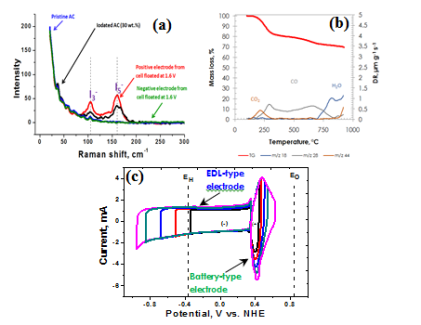
Qamar Abbas
Researcher
Title: Iodides confinement within activated carbon porosity resulting battery-type electrode for aqueous hybrid supercapacitor
Biography
Biography: Qamar Abbas
Abstract
Supercapacitors (SCs) generally use activated carbon (AC) electrodes and organic electrolytes e.g. 1 mol L-1 TEABF4 in acetonitrile due to the energy vs voltage square dependence. However, due to the flammable character of acetonitrile, environment-friendly and low cost alternatives e.g. neutral aqueous Li2SO4 (pH = 6.5-7.0) exhibiting moderate voltages up to 1.5 V in SCs have been recently proposed. Such voltage exceeding water stability of 1.23 V is due to large over-potential for di-hydrogen evolution at the negative carbon electrode caused by local downshift of pH. Lately, by introducing potassium iodide (KI) in aqueous Li2SO4, AC/AC hybrid cells operating up to 1.6 V displayed high capacitance as a result of hybridization of a battery-type positive electrode and capacitor-type negative one. The battery-type performance of the positive electrode is associated with redox reactions 2I- ↔ I2 + 2e- enhancing greatly the capacity of the positive electrode than for the negative one, C+>>C-, and using equation for capacitors in series 1/C = 1/C+ + 1/C-, capacitance of cell is equal to negative electrode capacitance.
Here, we show that hybrid capacitors in aqueous KI+Li2SO4 (pH = 6.5) using symmetric carbon configuration losses capacitance upon cycling/floating at 1.5 V. When using microporous carbons as positive and negative electrodes, the former reaches to +0.692 V vs SHE, and when implementing mesoporous electrodes, the negative electrode reaches to -0.985 V vs SHE well below the di-hydrogen evolution potential (-0.46 V vs SHE). Hence, both systems display capacitance loss under cycling/floating at 1.5 V. We implement asymmetric configuration using mesoporous carbon as positive electrode to better trap iodide species, and microporous carbon as negative one to improve hydrogen storage, to balance the system. TPD, Raman, Gas adsorption and electrochemical data on electrodes and cells (Figure 1) proves that the oxidation of positive electrode and hydrogen production on negative electrode are reduced, improving the cyclability, capacitance and energy efficiency of the cell up to 10,000 cycles.


